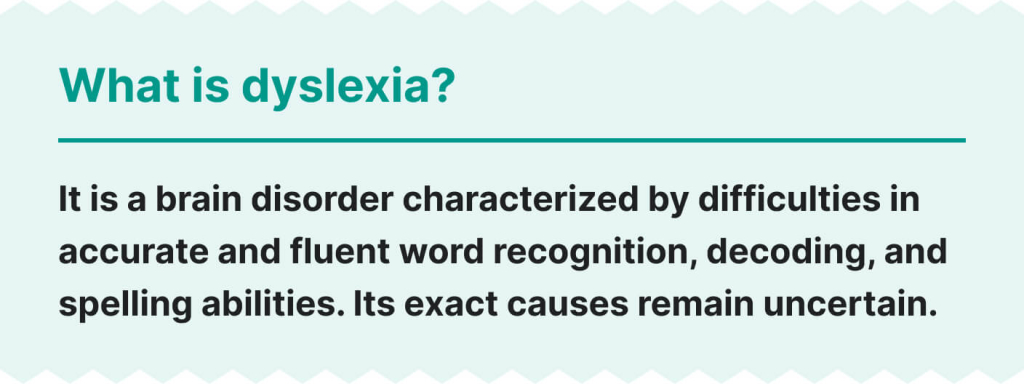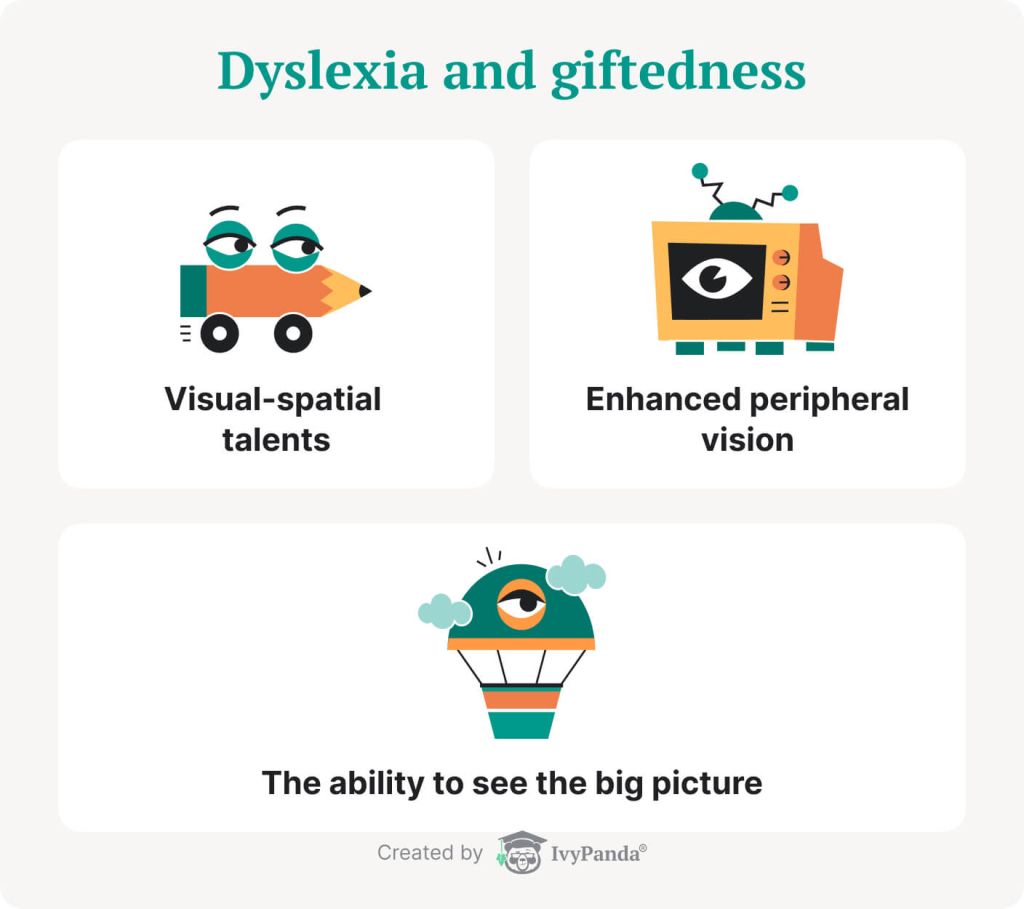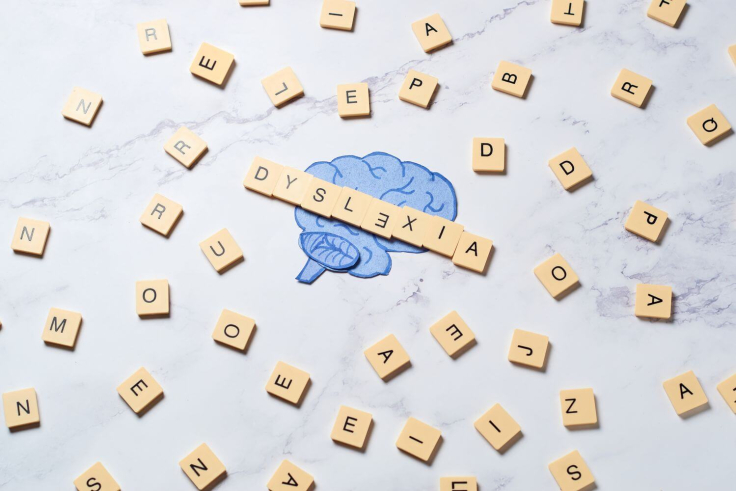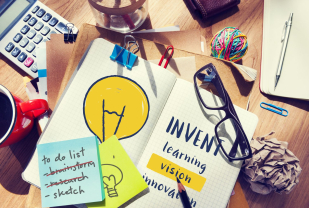Do you suspect you have dyslexia, or have you been diagnosed with it?
You are not alone, then.
Being a very common learning disorder, dyslexia affects 10 percent of people all over the world. Though it decreases one’s ability to read, write, and recognize letters, thereby making the learning process a challenge, many dyslexics have achieved impressive results in their careers.
Just search for “most famous dyslexics” and check. A few decades ago, diagnosing dyslexia was problematic. Still, researchers believe that George Washington, Albert Einstein, and Leonardo Da Vinci suffered from this disorder.
Statistics reveal a 62% high school dropout rate for those who suffer from reading difficulties. At the same time, dyslexia doesn’t equate to a lack of intelligence or potential. Success in studies and life is attainable if you use appropriate tools and strategies. In this article, we’ll offer practical advice and techniques for studying with dyslexia. We aim to empower you to overcome obstacles and achieve your goals.
🔤 What Exactly Is Dyslexia?
Dyslexia is a neurodevelopmental disorder that makes it challenging to recognize and spell words accurately and fluently. Though the exact causes of dyslexia are understudied, some scholars suggest that specific genes can increase its likelihood. The idea means that dyslexia might be an inherited thing.
However:
There are circumstances, such as low birth weight, preterm birth, and exposure to certain substances during pregnancy, that are also believed to increase dyslexia’s likelihood.

Some studies link dyslexia to a certain brain structure.
What does that mean?
For those with dyslexia, the brain develops and functions in a way that makes processing written language dramatically challenging.
In the academic setting, dyslexics may struggle to:
- Learn new words
- Recall symbols that match specific sounds
- Understand grammar and syntax
These challenges often make students frustrated, anxious, and inadequate. However:
It’s crucial to understand that dyslexia isn’t linked to intelligence. While the latter encompasses a broad spectrum of abilities, the former specifically impacts reading and language processing skills only, not overall cognitive ability.
📝 Signs & Symptoms of Dyslexia
Typically, dyslexia is diagnosed in childhood when a child starts learning to read and write.
However:
It can sometimes go unidentified until adulthood. Many individuals grapple with reading and spelling challenges throughout their lives without understanding the root of their struggles.
In an interview with The Hollywood Reporter, renowned actress Jennifer Aniston revealed that she was diagnosed with dyslexia in her early 20s. Growing up, she grappled with the condition, mistakenly believing she just wasn’t intelligent. She recalls that while reading, her eyes would skip ahead four words and then backtrack two.
Aniston exemplifies that dyslexia does not have to hinder someone’s success or aspirations. Her journey underscores the importance of timely diagnosis and intervention. Early support can provide solace and greatly enhance an individual’s ability to navigate dyslexia.
Let’s examine the primary symptoms that can help identify the disorder at various ages.

Signs of Dyslexia in Preschoolers
- Delayed speech
- Slow vocabulary acquisition
- Difficulty forming words and confusion with similar-sounding words
- Difficulty remembering letters and numbers
- Challenges with memorizing nursery rhymes and participating in rhyming games
Signs of Dyslexia in Schoolchildren
- Difficulty processing and understanding spoken words
- Challenges in choosing words and expressing thoughts
- Trouble recalling sequences
- Difficulty distinguishing between similar letters and words
- Struggles with pronouncing unfamiliar words based on their phonetic patterns
- Spelling challenges
- Taking longer than usual for reading or writing tasks
- Avoidance of reading activities
Signs of Dyslexia in Teens and Adults
- Difficulty with reading, including reading aloud
- Reading and writing at a slower pace
- Struggling with pronouncing names or words
- Taking longer than usual for reading and writing tasks
- Challenges summarizing stories
- Difficulty learning a foreign language
- Trouble solving math word problems
💝 Dyslexia and Giftedness
Despite dyslexia being classified as a learning disability, numerous distinguished individuals, including esteemed scientists, tech leaders, and inventors, have faced it. A prime example is Bill Gates.
Interestingly, research indicates that individuals with dyslexia have certain cognitive strengths.
For example:
They might have superior spatial navigation and a knack for seeing the bigger picture, both literally and figuratively.
You might wonder what causes this paradox. Several theories exist. One suggests that dyslexia activates regions in the right prefrontal cortex of the brain. These areas assist individuals in detecting anomalies or when something seems off. Research highlighted in Scientific America proposes that everyone is born with a sensitivity to “things out of place,” but this ability diminishes as we learn to read. Another theory posits that the strengths associated with dyslexia are adaptations the brain develops to counterbalance challenges in reading and writing.

In the next section, we’ll explore some of the most intriguing cognitive advantages linked to dyslexia.
Visual-Spatial Talents
Simply put, visual-spatial ability is something that allows one to process pictures in their mind. The skill includes mentally rotating objects, interpreting maps, and visualizing how components fit together.
An experiment by von Károlyi et al. showed that dyslexia is often accompanied by distinct visual-spatial abilities. The latter, in turn, help you perceive information as a whole rather than in segments.
In other words:
Dyslexics tend to see the big picture. Moreover, they excel in tasks that require visual thinking, like solving puzzles and creating art. This suggests they can identify and recall intricate patterns more quickly than others.
Enhanced Peripheral Vision
The results of a study in The New England Journal of Medicine show that dyslexics do feature the ability to distribute their attention more broadly than typical readers. This ability helps them absorb a wider range of information simultaneously.
This broader distribution of attention can be beneficial in many ways. In particular, it allows dyslexics to notice details others might overlook or to identify connections between seemingly unrelated information.
The Ability to See the Big Picture
People with dyslexia have a distinct ability to think creatively and see the connections that others might overlook. Their holistic approach to problem-solving allows them to visualize complex concepts. This skill is crucial in the entrepreneurial world.
A study identified a higher prevalence of dyslexics among entrepreneurs compared to the general population.
The findings indicate that certain strengths associated with dyslexia, such as innovative thinking, creativity, resilience, and determination, can lead to significant achievements in business.
🪢 Possible Difficulties & Related Conditions
Dyslexia frequently coexists with other disorders, such as:
Moreover:
One of the key challenges for individuals with dyslexia is the increased risk of anxiety disorders.
Dyslexia can make it challenging to:
- Keep pace with classroom activities
- Meet deadlines
- Match peer performance
As a result, students with dyslexia often feel self-conscious about their struggles, leading to anxiety, low self-esteem, and a fear of failure.
Our advice to students with dyslexia is:
- Recognize and accept the challenges this condition presents; understanding your diagnosis is essential for navigating its associated difficulties.
- Don’t hesitate to let your professors know about your dyslexia. This will enable them to adapt their teaching methods, allow additional time for assignments and exams, and suggest alternative learning approaches.
- Remember, dyslexia does not define you; with the right mindset and support, you can achieve all your goals.
📘 Study Tips for Dyslexic Students
Educational professionals and students shared their dyslexia strategies with us. We’ve compiled 7 categories of study tips specifically for dyslexic adults to aid in your success.

1. Motivation
Motivation is crucial for maintaining a positive outlook on your studies and boosting self-confidence. Here are tips to keep you inspired regardless of challenges.
Get Inspired by Success Stories
Many famous individuals with dyslexia, such as John Lennon, Whoopi Goldberg, Jamie Oliver, and Tom Cruise, have thrived in their careers. Some were diagnosed as adults and faced many challenges in their early years. Exploring their biographies or documentaries can offer motivation during tough times.
Set Realistic Goals
Consider setting SMART goals to focus your efforts, monitor progress, and achieve success. SMART goals are specific, measurable, achievable, relevant, and time-bound.
For example, instead of saying, “I need to read better,” consider framing it as a SMART goal for better results.
Reward Yourself
Rewarding yourself for reaching milestones keeps you motivated. Celebrating small victories boosts your confidence and promotes perseverance. Remember that rewards don’t always need to be monetary; enjoy activities you love as a treat.
2. Organization
Organizing your study routine is crucial to reduce distractions and conserve energy, allowing those with dyslexia to focus on their goals. Below are some practical organizational strategies to enhance your productivity.
Organize Your Study Space
Let’s start with practical tips to organize your study space:
- Separate your study area from the rest of your room to reduce distractions.
- Keep essential study tools in one spot and avoid moving them.
- Place a planner or calendar above your desk to track deadlines.
- Use color-coded folders for each subject for easy organization.
- Consider using dividers in your notes to separate units for quick reference.
- Set up electronic folders and subfolders on your computer for various topics, assignments, or modules.
- Back up your files using memory sticks, cloud storage, or email.
Create a Schedule
You can benefit greatly from a carefully scheduled week to manage your time and reduce stress. Use a paper planner or phone calendar to track study sessions and assignments. Checking your planner regularly helps you stay on track and avoid feeling overwhelmed.
Last but not least:
Remember to schedule regular breaks. Setting reminders and using sticky notes for important details can be helpful.
Get Focused
To maintain focus, use multisensory learning strategies. This involves activities like writing, highlighting, discussing, or making mind maps.
It’s also crucial to minimize distractions in your study environment. Consider turning off the TV or setting your phone to silent. By eliminating distractions, you avoid getting sidetracked.
While having a consistent study spot is helpful, some students may prefer to change their locations from time to time. Just make sure the chosen place is quiet and conducive to studying.
3. Note-taking
As previously discussed, individuals with dyslexia often have strong visual-spatial abilities.
Research also indicates that dyslexia boosts the brain’s visual memory as a compensatory mechanism.
Given these strengths, we suggest exploring two unconventional note-taking techniques to enhance your academic success.
Try Mind Maps
Consider these three visual and multisensory note-taking methods:
- Mind maps are visual diagrams that organize information around a central idea, branching into related ideas and subtopics. They utilize colors, symbols, and images for enhanced memorability.
- Concept maps are like mind maps, but they emphasize the relationships between ideas. They use lines, arrows, and labels to illustrate connections.
- Flowcharts are diagrams detailing the sequential steps of a task or activity, often incorporating feedback loops for added ideas or questions.
We recommend checking out this article about the above-mentioned techniques for more information.
Use Sketchnoting
Sketchnoting is a visual technique combining handwritten notes with doodles and other visuals. It enables you to process information using visual strengths instead of relying solely on reading and writing. Using colored pencils can enhance the visual impact.
Sketchnoting takes practice, so don’t be discouraged if your initial attempts aren’t perfect. If you’re interested in learning more, check out this guide on sketchnoting.
4. Writing
Dysgraphia and dyslexia are distinct disorders, but research indicated shared causes for both. While dysgraphia primarily impacts writing abilities, making coherent text production difficult, dyslexia can affect reading comprehension, complicating the gathering of information for writing.
Notably, another study reveals a high co-occurrence between dyslexia and dysgraphia. Many individuals with dyslexia also face dysgraphia challenges, and vice versa.
Consider these writing tips:
- Analyze and understand the topic before starting to write. Focus on a specific question rather than covering everything you know.
- Engage in brainstorming. Jot down all ideas that come to mind on a piece of paper and identify connections between them.
- Develop a clear outline to guide your essay’s structure. Using essay templates can make this process easier.
- Take regular breaks. Writing can be taxing, and resting can help improve your focus and productivity.
- Review your work. Proofread multiple times for spelling, coherence, and topic relevance.
5. Reading
Reading skills acquisition is especially challenging for dyslexics.
However:
They can be developed if proper support is given. The key is to be patient and not overly concerned about the progress. With dedication and tips tailored for dyslexic readers, anyone can significantly improve their reading abilities.
For those who have never struggled with reading but wish to understand the experience, consider trying the Dyslexia Simulator.
Here are some helpful reading tips for students with dyslexia:
- Read about 20 minutes a day. Work with the books, newspapers, and magazines that interest and inspire you.
- Use a ruler to guide your eyes through the text. This simple trick will help you maintain focus. Keep a pen or highlighter nearby to mark important points or make notes.
- Vocalize words as you read. This technique will help you minimize reading errors. By seeing and hearing the words on the page at the same time, you will better comprehend the text.
Use SQ3R Method
There is an effective method for improving reading comprehension. It is known as the SQ3R technique.
Here’s a breakdown of each step:
6. Learning
Working memory refers to the cognitive ability to hold and manipulate information in your mind while actively performing mental tasks. It plays a crucial role in learning, problem-solving, and concentration.
Working memory has 2 components:
- A phonological loop for storing verbal information.
- A visuospatial “sketchpad” for storing visual and spatial data.
While dyslexia may affect the phonological loop, the visuospatial functions often remain intact. Thus, for students with dyslexia aiming to improve their working memory, visualizing the information they need to learn can be beneficial.
If you want to learn more about the connection between working memory and dyslexia, check out this article by the Dyslexia Help Center at the University of Michigan.
Stimulate Your Memory
So, what dyslexia memory techniques are the most effective?
7. Preparing for Exams
A recent study showed that students with dyslexia often face higher exam anxiety than their peers. This anxiety stems from concerns about their performance, time constraints, and the fear of making mistakes.
Luckily:
Thorough preparation can help alleviate this anxiety. Focused revision can identify areas that require extra attention and develop confidence in your understanding of the material.
Have a look at these valuable revision tips:
- Figure out what will be on the exam. Ask your teachers about what to expect.
- Make a comprehensive checklist for each subject. As you study, check off completed topics to track your progress.
- Set up a revision schedule. Make sure you distribute your study time evenly to address all the subjects throughout the week.
- Familiarize yourself with past exams to understand question formats. Practice answering them for familiarity.
- Wake up early on exam days to review the material again, keeping it fresh in your mind.
🌐 Valuable Resources for Students with Dyslexia
As a bonus, we compiled some great resources for students with dyslexia. We hope you will find them helpful.
Arije-Aike de Haas’ Channel
Arije-Aike de Haas’ YouTube channel is an invaluable resource for students with dyslexia. Being dyslexic, Arije-Aike offers personal insights, practical advice, and techniques to navigate educational and daily challenges. The channel provides insightful content tailored to support and empower students with dyslexia on their academic journey.
Davis Dyslexia Association Blog
The Davis Dyslexia Association International Blog stems from an educational organization rooted in Ronald Davis’s approach. Ronald D. Davis made a breakthrough discovery that helped him overcome his own dyslexia at the age of 38. With informative articles and practical strategies, this blog offers support and guidance. It helps students recognize their learning differences and gain inspiration from success stories.
Dyslexia Help Center of UMich
A collection of books by the Dyslexia Help Center of UMich provides helpful information for anyone interested. Each book is accompanied by an annotation that will help you decide whether to read it. Some of our favorites are “Bigger Than Me: How a Boy Conquered Dyslexia to Play with the NFL” by Jovan Haye and “Academic Success Strategies for Adolescents with Learning Disabilities & ADHD” by Esther H. Minskoff & David Allsopp.
Dyslexic Advantage
Dyslexic Advantage is a platform for dyslexics to connect, learn, and harness the strengths associated with dyslexia. It offers a range of resources able to enhance learning and embrace the unique abilities of dyslexic students.
Canva
Canva.com is a free design platform that offers a wide range of templates, fonts, and graphics. Canva’s tools are a great help to those who want to create flashcards and other visuals able to enhance one’s ability to learn.
MindMup
MindMup.com is a powerful mind-mapping tool with numerous free options. The platform will assist you in visually organizing all your thoughts and ideas. Even more, you will be able to structure them in a customized manner that aligns with your learning requirements.
Thank you for reading this article!
To sum up, studying with dyslexia may indeed pose unique challenges. Still, it should never limit your potential. If you have found this article helpful, we encourage you to share it with your friends or on social media so that others can also benefit from these valuable strategies.



